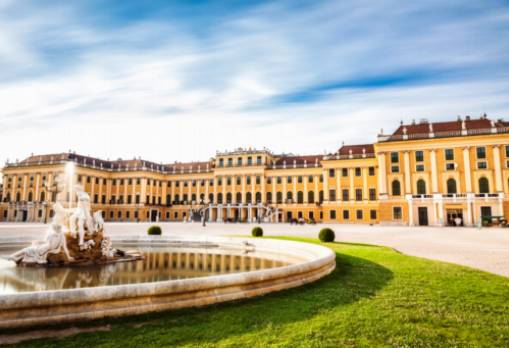Nestled in the heart of Vienna, the Hofburg Palace stands as a testament to the grandeur and power of the Austrian Imperial family, the Habsburgs. This magnificent palace, with its blend of Baroque, Gothic, and Renaissance styles, showcases the opulence and luxury that once characterized the ruling dynasty. Step inside and explore the lavish living quarters of the Austrian Emperors, marvel at the treasures of the Habsburgs on display in the palace museums, and experience the sacred heart of the empire at the Hofburg Palace Chapel. Join us on a journey through history as we unravel the secrets and splendor of this iconic symbol of Austrian imperial power.

Hofburg Palace Architecture: A Blend of Baroque, Gothic, and Renaissance Styles
Hofburg Palace, located in the heart of Vienna, Austria, is a magnificent architectural masterpiece that blends elements of Baroque, Gothic, and Renaissance styles. The palace, originally built in the 13th century, underwent numerous renovations and expansions over the centuries, resulting in a harmonious fusion of different architectural influences.
The Baroque style is prominently displayed in the grand facades and ornate decorations of the palace. Elaborate Baroque sculptures adorn the exterior of the building, adding a sense of opulence and grandeur. The intricate details and lavish ornamentation of the Baroque style create a sense of drama and luxury, reflecting the power and wealth of the Habsburg dynasty.
The Gothic elements of Hofburg Palace can be seen in its soaring towers, pointed arches, and intricate tracery. The tall spires and slender columns of the Gothic architecture give the palace a sense of verticality and grandeur, symbolizing the spiritual and earthly power of the Habsburg rulers. The intricate stonework and delicate filigree of the Gothic style add a sense of mystery and romance to the palace's overall design.
The Renaissance influence on Hofburg Palace can be seen in its symmetrical layout, classical elements, and harmonious proportions. The clean lines and geometric patterns of the Renaissance style create a sense of balance and order in the palace's design. The use of classical motifs, such as columns, pilasters, and pediments, adds a sense of elegance and sophistication to the architectural composition.
Overall, the blend of Baroque, Gothic, and Renaissance styles in Hofburg Palace creates a unique and cohesive architectural expression that reflects the rich history and cultural diversity of Austria. The palace stands as a testament to the artistic and political achievements of the Habsburg dynasty, embodying the grandeur and splendor of imperial power in Central Europe.
Hofburg Palace Museums: Exploring the Treasures of the Habsburg Dynasty
The Hofburg Palace in Vienna is not only a magnificent architectural marvel, but also a treasure trove of artifacts and artworks that showcase the grandeur and opulence of the Habsburg Dynasty. The museums housed within the palace complex offer visitors a glimpse into the rich history and culture of the imperial family.
One of the most notable museums within the Hofburg Palace is the Imperial Silver Collection, where visitors can marvel at the exquisite tableware and accessories used by the Habsburg emperors and empresses for their elaborate banquets and ceremonies. The collection includes intricately designed silverware, porcelain, and glassware that reflect the impeccable taste and luxury enjoyed by the imperial family.
Another must-visit museum is the Sisi Museum, dedicated to the iconic Empress Elisabeth of Austria, also known as Sisi. This museum offers a fascinating insight into the life and legacy of the enigmatic empress, showcasing her personal belongings, including her stunning gowns, jewelry, and accessories. Visitors can learn about Sisi's unconventional lifestyle, her beauty secrets, and her enduring impact on Austrian history.
In addition to these specialized museums, the Hofburg Palace is also home to the Imperial Apartments, a series of lavishly decorated rooms that once served as the living quarters of the Austrian emperors and empresses. Visitors can wander through the sumptuous chambers and admire the exquisite furniture, paintings, and decorations that adorned the private spaces of the imperial family.
Exploring the museums of the Hofburg Palace is a truly mesmerizing experience that offers a glimpse into the opulent world of the Habsburg Dynasty. From the glittering silverware of imperial banquets to the personal belongings of Empress Sisi, these museums showcase the rich heritage and cultural legacy of one of Europe's most powerful ruling families.
Imperial Apartments: Inside the Lavish Living Quarters of Austrian Emperors
The Imperial Apartments of Hofburg Palace offer a glimpse into the lavish living quarters of the Austrian emperors. These opulent rooms are filled with exquisite furnishings, intricate decorations, and priceless artworks that reflect the wealth and power of the Habsburg dynasty. Visitors can explore the private chambers, grand reception rooms, and luxurious dining areas that were once inhabited by the rulers of the empire. Each room is meticulously decorated with ornate tapestries, gold leaf accents, and intricate ceiling frescoes, creating a truly majestic ambiance that transports visitors back in time to the height of the Austrian Empire. Walking through the Imperial Apartments, it is easy to imagine the grandeur and extravagance in which the emperors and their families lived, surrounded by beauty and luxury at every turn.
Hofburg Palace Chapel: The Sacred Heart of the Habsburg Empire
The Hofburg Palace Chapel is a sacred space that holds great significance within the Habsburg Empire. As the religious center of the imperial family, the chapel played a vital role in the spiritual life of the dynasty. Richly decorated with intricate details and ornate furnishings, the chapel reflects the power and grandeur of the Habsburg rulers. Visitors can admire the stunning architecture and exquisite artwork that adorns the chapel, gaining a glimpse into the religious practices of the imperial court. It remains a symbol of faith and devotion in the heart of the Habsburg Empire, showcasing the deep connection between religion and power in Austrian imperial history.
